#CRM migration pitfalls
Explore tagged Tumblr posts
Text
Avoid common Salesforce Lightning migration mistakes by understanding these key challenges. This guide offers practical solutions for a seamless transition.
#Salesforce Lightning migration#Salesforce migration mistakes#CRM migration pitfalls#Salesforce Lightning tips#avoid CRM migration issues.
1 note
·
View note
Text
Odoo Implementation Partner: Your Guide to Seamless ERP Success
In today’s fast-evolving business landscape, efficiency and scalability are key to long-term success. Implementing a robust ERP (Enterprise Resource Planning) system like Odoo can streamline your operations and give your business a competitive edge. However, a successful Odoo implementation requires expertise, strategic planning, and a deep understanding of your business processes. That’s where an Odoo implementation partner comes in.
Choosing the right Odoo implementation partner is crucial to ensuring a smooth transition and maximizing your return on investment. In this blog, we’ll explore why you need an Odoo implementation partner, how to choose the right one, and the benefits they bring to your business.
What Is an Odoo Implementation Partner?
An Odoo implementation partner is a certified and experienced organization that helps businesses implement, customize, and deploy the Odoo ERP system. They act as your trusted advisor, guiding you through the entire process—right from planning and configuration to customization, training, and ongoing support.
These partners possess deep expertise in Odoo’s functionalities and modules, enabling them to tailor the solution to your business’s unique requirements. With their help, you can avoid common implementation pitfalls and ensure your ERP system is optimized for success.
What Does an Odoo Implementation Partner Do?
Business Process Analysis: Assess your current workflows to understand pain points and improvement areas.
System Configuration: Configure Odoo modules to align with your business processes.
Customization: Tailor the system to meet your specific business needs with custom workflows and reports.
Data Migration: Safely transfer data from legacy systems to Odoo.
Training and Support: Ensure your team is well-trained and provide ongoing support to resolve any issues.
Why Do You Need an Odoo Implementation Partner?
While Odoo is a powerful and flexible platform, implementing it without professional guidance can be risky. An experienced partner brings the technical expertise and industry knowledge necessary for a successful deployment. Here are some reasons why partnering with an Odoo implementation expert is a smart move:
1. Expertise and Experience
Odoo implementation requires in-depth knowledge of the system and how it can be customized to meet business needs. An experienced partner has successfully implemented Odoo for various industries and knows how to handle complex projects.
2. Time and Cost Efficiency
Implementing Odoo without the right expertise can lead to delays, costly errors, and resource wastage. An implementation partner ensures the process is completed on time and within budget.
3. Customization and Integration
Every business is unique, and Odoo’s standard features might not cover all your requirements. A partner can customize modules and integrate third-party applications to create a tailored solution.
4. Data Security and Migration
Data migration is one of the most critical steps in ERP implementation. A partner ensures that your data is migrated accurately and securely without compromising its integrity.
5. Training and Support
A successful implementation doesn’t end with deployment. Your team needs proper training to use the system effectively. A reliable partner provides continuous support to address any technical challenges.
Key Steps in Odoo Implementation
Implementing Odoo is a multi-step process that requires careful planning and execution. Here’s an overview of the key steps involved:
1. Requirement Analysis
The process begins with understanding your business needs and defining the scope of the project. This step helps in identifying the modules required and the level of customization needed.
2. System Design and Configuration
Once the requirements are clear, the partner configures Odoo to align with your business processes. This includes setting up modules for accounting, sales, CRM, inventory, HR, and more.
3. Customization and Development
Customization is done to ensure the system fits your business workflows perfectly. This can involve creating custom modules, modifying workflows, and integrating third-party applications.
4. Data Migration
Legacy data is transferred to Odoo, ensuring that critical business information is preserved and accessible in the new system.
5. User Training
A successful ERP implementation depends on how well your team adopts the system. Training sessions are conducted to familiarize users with the new workflows and features.
6. Go-Live and Support
Once the system is ready, it goes live. Post-implementation support is crucial for addressing any issues that arise and ensuring the system runs smoothly.
How to Choose the Right Odoo Implementation Partner
Selecting the right Odoo implementation partner can be challenging, given the number of options available. Here are some key factors to consider:
1. Experience and Certification
Choose a certified Odoo partner with a proven track record of successful implementations. Look for case studies and client testimonials.
2. Industry Expertise
Each industry has unique requirements. Ensure the partner has experience working in your industry and understands its specific challenges.
3. Customization Capabilities
A good partner should offer extensive Odoo customization services to adapt to your business needs.
4. Integration Experience
If you rely on multiple business applications, choose a partner with expertise in integrating Odoo with third-party tools like payment gateways, CRM, e-commerce platforms, and more.
5. Post-Implementation Support
Ensure the partner offers ongoing support and maintenance services to help you get the most out of your Odoo system.
Benefits of Working with an Odoo Implementation Partner
Partnering with an Odoo expert can significantly enhance your ERP implementation experience. Here’s what you gain:
Tailored Solutions: Get a solution customized for your business operations.
Reduced Downtime: Minimize disruptions during implementation and go-live.
Improved Efficiency: Streamlined processes and better resource management.
Scalability: Easily scale your Odoo system as your business grows.
24/7 Support: Resolve issues quickly with reliable post-implementation support.
Why Choose Banibro IT Solution as Your Odoo Implementation Partner?
At Banibro IT Solution, we specialize in delivering end-to-end Odoo implementation services that help businesses streamline operations and improve productivity. With years of experience and a team of certified Odoo experts, we are your trusted partner for a seamless ERP journey.
What Sets Us Apart?
Certified Odoo Experts
Industry-Specific Solutions
Comprehensive Support
Agile Implementation Approach
Affordable and Transparent Pricing
Conclusion: Empower Your Business with the Right Odoo Partner
An experienced Odoo implementation partner can transform how your business operates, making processes more efficient and scalable. By working with a trusted partner like Banibro IT Solution, you can ensure a smooth implementation and unlock the full potential of Odoo ERP.
Ready to get started?Contact Banibro IT Solution today for a free consultation and see how our expertise can help your business thrive with Odoo.
0 notes
Text
Salesforce Consulting Services: Empowering Your CRM Strategy
In today’s highly competitive business landscape, managing customer relationships effectively is essential for growth. Salesforce, one of the world’s leading CRM platforms, offers a wide range of tools to help businesses achieve this goal. However, to fully leverage Salesforce’s capabilities and ensure it aligns with your company’s needs, expert guidance is often necessary. That’s where Salesforce consulting services come in. These services help businesses maximize the value of their Salesforce investment by providing tailored solutions, implementation support, and ongoing optimization.
What Are Salesforce Consulting Services?
Salesforce consulting services are provided by specialized consultants who help organizations deploy, customize, and manage Salesforce effectively. Whether you’re just getting started with Salesforce or looking to improve an existing setup, consultants ensure that your system is configured to meet your specific business needs. From system implementation and data migration to staff training and integration with other software, Salesforce consultants help businesses unlock the full potential of the platform.
Why You Need Salesforce Consulting Services
Customized Solutions for Your Business Needs Every business is different, and so are its requirements. Salesforce consultants work with you to understand your processes, challenges, and goals. They then tailor Salesforce to fit your unique business needs, ensuring it enhances productivity, simplifies workflows, and aligns with your overall objectives.
Expertise You Can Trust Salesforce is a robust platform with many features and customization options. Salesforce consultants have the expertise to guide you through the complexities of setup, configuration, and optimization. Their deep knowledge of the platform allows them to avoid common pitfalls, ensuring a smooth implementation and minimizing disruptions to your operations.
Accelerated Implementation and Return on Investment (ROI) Implementing Salesforce without expert help can be time-consuming and prone to errors. Consultants streamline the process, helping you get the system up and running quickly. By ensuring Salesforce is properly configured and optimized from the start, consultants help you realize ROI faster and maximize the value of your investment.
Enhanced User Adoption A successful Salesforce implementation is not just about the software; it's also about ensuring that your team uses it effectively. Salesforce consultants provide training and support to ensure that your employees are comfortable with the system. They also help customize the platform to make it more user-friendly, which leads to higher adoption rates and improved productivity.
Ongoing Support and Optimization The business world is constantly evolving, and so are your needs. Salesforce consultants offer ongoing support to make sure your Salesforce instance continues to meet your business goals. Whether it's optimizing workflows, integrating new features, or addressing issues, consultants ensure that your CRM adapts to your changing needs over time.
Types of Salesforce Consulting Services
Salesforce Implementation The first step in getting the most out of Salesforce is implementing it effectively. Consultants guide you through the entire process, from initial planning and design to deployment. They handle everything from data migration to system configuration, ensuring that Salesforce is seamlessly integrated into your business processes.
Salesforce Customization Salesforce offers extensive customization options, but to make it work for your specific business, it needs to be tailored. Consultants can configure reports, dashboards, workflows, and other features to meet your exact needs. Customization ensures that Salesforce becomes a tool that supports your unique operations and goals.
Salesforce Integration Businesses often use a variety of software systems to manage different aspects of their operations. Salesforce consultants can integrate your CRM with other tools, such as marketing platforms, accounting systems, or e-commerce solutions. This integration ensures a seamless flow of data across systems, enhancing efficiency and reducing the risk of data silos.
Salesforce Training and Support To fully leverage Salesforce, your team needs to understand how to use it. Consultants provide in-depth training tailored to your team’s roles and responsibilities. They also offer ongoing support to resolve any issues and ensure that your team is consistently using Salesforce to its full potential.
Salesforce Optimization As your business grows and evolves, so should your CRM. Salesforce consultants perform regular audits to ensure your Salesforce setup remains aligned with your changing needs. They recommend improvements, implement new features, and fine-tune the system to keep it running efficiently.
Why Invest in Salesforce Consulting Services?
Salesforce consulting services aren’t just about setting up a CRM; they’re about driving business transformation. By working with a consultant, you can avoid costly mistakes, streamline processes, and unlock the full potential of Salesforce. With expert guidance, you’ll ensure that your CRM is working at its best, helping you enhance customer relationships, improve sales performance, and foster business growth.
Conclusion
Salesforce is one of the most powerful CRM platforms available, but to truly make it work for your business, you need expert help. Salesforce consulting services offer the guidance, support, and customization needed to maximize the value of the platform. Whether you’re looking for initial implementation, system optimization, or ongoing support, a Salesforce consultant can help you achieve your business goals more effectively and efficiently.
1 note
·
View note
Text
Why Your Business Needs NetSuite Managed Services for Optimal Performance
In today's fast-paced and ever-evolving business landscape, companies are increasingly turning to cloud-based solutions to streamline operations, enhance efficiency, and drive growth. Among the most robust platforms for managing various aspects of business processes is NetSuite. As a leading Enterprise Resource Planning (ERP) and Customer Relationship Management (CRM) solution, NetSuite offers businesses a comprehensive suite of tools to handle everything from financial management to inventory control, eCommerce, and customer relationships.
However, to truly harness the full potential of NetSuite, companies need more than just the software—they require the expertise of a NetSuite CRM company and NetSuite consultants who can guide the implementation and ongoing optimization of the system. This is where NetSuite Managed Services come into play. In this blog, we’ll explore why your business needs NetSuite Managed Services for optimal performance and how a NetSuite solution provider can help drive success.

What Are NetSuite Managed Services?
NetSuite Managed Services refer to the ongoing support and optimization of your NetSuite system, ensuring that it continues to operate smoothly, efficiently, and in line with your business objectives. These services are typically provided by a NetSuite solution provider, a team of NetSuite ERP consultants, or a specialized NetSuite CRM company with deep expertise in the platform.
NetSuite Managed Services go beyond simple IT support. They include activities such as:
System monitoring and performance optimization
Data migration and integration with other software tools
Customization of NetSuite modules to fit business needs
User training and support
Ongoing updates and patch management
By partnering with a NetSuite CRM company or NetSuite consultants, businesses can ensure that their NetSuite system is always aligned with their evolving needs and industry best practices.
Benefits of NetSuite Managed Services
Maximize the Value of NetSuite CRM and ERP Systems
NetSuite offers a powerful combination of CRM and ERP capabilities that can significantly improve your business operations. However, the key to maximizing these benefits lies in proper implementation and continuous optimization. NetSuite CRM companies and NetSuite ERP consultants possess the expertise to tailor the platform to meet your specific business requirements, ensuring that every module—from financial management to sales and marketing automation—works seamlessly together. This ensures you get the most out of your investment in NetSuite.
Expert Guidance from Experienced Consultants
When you engage with a NetSuite solution provider, you're tapping into a team of experts who know the ins and outs of the platform. NetSuite consultants can help you navigate complex configurations, integrations, and customizations to ensure that your system is optimized for your specific business processes. With the help of NetSuite ERP consultants, you can implement best practices that align with your industry and avoid common pitfalls that could derail your project.
By working with professionals who understand the intricacies of NetSuite, you can avoid costly mistakes and delays that may arise from attempting to manage the platform on your own. The ongoing support from these experts also means that you can quickly address any challenges or issues that arise, ensuring minimal downtime and disruption to your business.
Improve System Performance and Efficiency
A poorly optimized NetSuite system can quickly become a bottleneck, hindering your business's ability to scale and operate efficiently. With NetSuite Managed Services, you have a dedicated team monitoring your system’s performance and making proactive improvements. Whether it’s fine-tuning workflows, optimizing data storage, or ensuring that your integrations are running smoothly, NetSuite ERP consultants can help ensure your system is always performing at its best.
Ongoing optimization also involves keeping your system up to date with the latest features and updates that NetSuite releases. By working with a NetSuite solution provider that offers managed services, your system will stay current, ensuring that you are always using the most advanced tools and technologies available.
Reduce IT Complexity and Operational Costs
Managing NetSuite on your own can be complex and time-consuming. With NetSuite Managed Services, you can offload the responsibility of day-to-day system maintenance to experts, allowing your internal team to focus on strategic initiatives that drive growth. This not only reduces the strain on your in-house IT resources but also lowers operational costs associated with hiring and training dedicated NetSuite staff.
Additionally, because a NetSuite CRM company or NetSuite consultants can identify and resolve issues quickly, they can help prevent costly system downtimes, missed opportunities, and inefficiencies that can arise from misconfigured or outdated systems. In the long run, this results in significant cost savings and better ROI.
Scale Your Business with Confidence
As your business grows, your NetSuite system will need to evolve to accommodate new processes, additional users, and expanded capabilities. With NetSuite Managed Services, you have the peace of mind knowing that your system can scale alongside your business needs. Whether it’s adding new modules, integrating third-party applications, or expanding your user base, a NetSuite solution provider can ensure that your system remains agile and adaptable to changing requirements.
Better Security and Compliance
With increasing data privacy regulations and cybersecurity threats, it’s more important than ever to ensure that your business’s systems are secure and compliant. A NetSuite CRM company with managed services is well-versed in the latest security protocols and regulatory requirements. By continuously monitoring your system and applying necessary updates and patches, they can safeguard your data against potential breaches and ensure that your system meets the latest compliance standards.
Conclusion
To truly unlock the full potential of your NetSuite system, your business needs more than just the software; it needs the expertise of a trusted NetSuite solution provider that can guide you through implementation, optimization, and ongoing support. With NetSuite Managed Services, you can maximize the performance of your NetSuite CRM and ERP systems, improve efficiency, reduce operational costs, and scale your business with confidence. Whether you're looking to optimize workflows, enhance user adoption, or ensure compliance, partnering with experienced NetSuite consultants can help you achieve your business goals more effectively.
If you're ready to take your business to the next level, consider engaging with a reputable NetSuite CRM company and investing in NetSuite Managed Services to ensure that your system is always running at peak performance. The benefits are clear: improved efficiency, better security, reduced costs, and a more agile, scalable business—key factors that will drive your long-term success.
0 notes
Text
Navigating the Salesforce Framework: How TechForce Services as Implementation Partners Simplify the Process
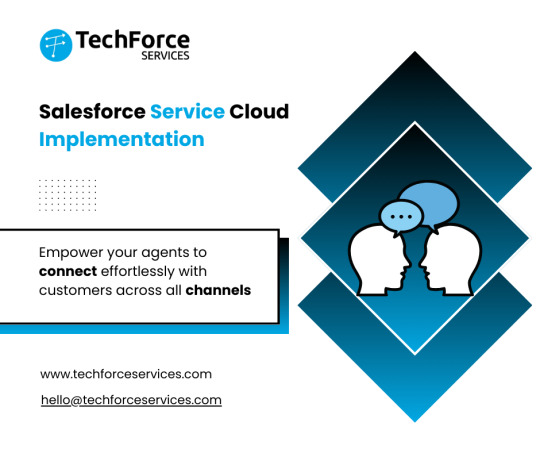
In today’s fast-paced business landscape, an efficient Customer Relationship Management (CRM) system is crucial. Salesforce, one of the leading CRM platforms, offers robust solutions, especially with its Salesforce Service Cloud. However, with a wide array of functionalities and a complex setup, implementation can be daunting for many businesses. This is where CRM implementation services come in.
For companies looking to optimize their customer support operations, partnering with experts like TechForce Services helps simplify the process, ensuring businesses can fully leverage Salesforce without disrupting core operations.
Why Choose Salesforce Service Cloud?
Salesforce Service Cloud is a powerful CRM solution designed to elevate customer support. It empowers organizations to manage cases, streamline workflows, and provide exceptional, personalized support. By unifying interactions across multiple channels—phone, email, chat, and social media—Salesforce Service Cloud makes it easier to provide seamless service. Additionally, Service Cloud offers advanced analytics, automation tools, and AI-driven insights, allowing businesses to make data-backed decisions to enhance customer satisfaction.
However, successful implementation is crucial to maximizing these benefits. TechForce Services, as a trusted Salesforce implementation partner, provides the expertise needed to navigate this complex process and align Salesforce capabilities with business goals.
The Challenges of CRM Implementation
CRM implementation is a strategic undertaking that involves more than just installing software. Key steps in CRM implementation include:
Assessment and Planning: Defining business objectives, identifying end-user requirements, and setting clear KPIs.
Customization: Tailoring Salesforce Service Cloud features to fit specific workflows, from case management to automation.
Data Migration: Moving existing customer data securely and accurately from legacy systems.
Training and Support: Ensuring employees are trained to maximize the platform’s potential.
Ongoing Optimization: Continuously fine-tuning the system to meet evolving business needs.
Without guidance, these steps can quickly overwhelm in-house teams. TechForce Services offers a streamlined, efficient approach that helps businesses avoid common pitfalls and keep their focus on growth.
How TechForce Services Simplifies CRM Implementation
TechForce Services specializes in guiding companies through the setup, customization, and integration of Salesforce Service Cloud. As an implementation partner, TechForce brings extensive knowledge and a structured approach to handle all aspects of the project with ease. Here’s how they simplify the process:
1.Expert Project Management
TechForce Services manages each phase of the CRM implementation project, including timelines, resources, and budgets. Their project management approach minimizes disruptions, accelerates implementation, and helps businesses start using Salesforce Service Cloud sooner to see a return on investment.
2.Tailored Solutions
Recognizing that every business is unique, TechForce tailors Salesforce Service Cloud to match specific needs. From workflow customization to setting up unique reporting metrics, TechForce ensures that the platform’s features align with a company’s customer service model. By providing a custom-fit solution, they help organizations create a CRM that truly enhances their customer experience.
3.Seamless Data Migration
Migrating data from legacy systems into Salesforce can be complex and time-consuming. TechForce Services uses advanced data migration tools and techniques, ensuring data accuracy and integrity throughout the process. Their data experts also map and organize data structures so that teams can easily access information within the new system.
4.Comprehensive Training and Support
For a CRM system to be effective, users must be proficient in using its features. TechForce offers training programs that accommodate different skill levels, from beginners to advanced users. Their training prepares teams to maximize Salesforce’s potential from day one. Additionally, they offer ongoing support, so if issues arise or users have questions, TechForce is there to assist.
5.Enhanced Security and Compliance
Customer data security is paramount, especially in a CRM system. TechForce Services brings deep knowledge of Salesforce’s security settings, ensuring that the platform meets all industry compliance standards. By implementing best security practices, they safeguard sensitive data and ensure companies adhere to all necessary regulations.
6.Ongoing Optimization and Support
Implementation is just the beginning. As businesses grow, their CRM must adapt to new needs. TechForce Services offers ongoing optimization services to help businesses leverage the latest features, address changes in customer support needs, and maintain a competitive edge.
The CRM Implementation Process with TechForce Services
With TechForce as a partner, Salesforce CRM implementation becomes a streamlined journey that follows these essential steps:
Discovery and Planning: TechForce starts by conducting a comprehensive assessment of the existing systems and business goals, developing a roadmap for implementation.
Customization and Configuration: They configure Salesforce features such as automated workflows, AI chatbots, and case routing, specifically tailored to the organization’s requirements.
Data Migration: TechForce safely transfers data, ensuring clean, organized information in the new CRM.
Thorough Testing: Rigorous testing ensures that every function operates seamlessly before going live.
Training and Controlled Launch: End-users are trained, followed by a structured launch to guarantee smooth adoption.
Post-launch Optimization: TechForce offers continued support to fine-tune the CRM and troubleshoot any potential issues.
Benefits of Partnering with TechForce Services
Efficient Implementation
TechForce ensures a swift and organized process, reducing the time it takes to implement Salesforce and minimizing potential downtime for your team. Their experts work within established timelines to enable a quick transition, allowing you to start reaping the benefits of Salesforce Service Cloud sooner.
Customized Workflows and Automations
With TechForce, businesses gain customized workflows and automated processes tailored specifically to their needs. Whether your team requires unique case routing, custom dashboards, or data-driven insights, TechForce configures Salesforce to work for you.
Improved Team Adoption
A CRM system is only as effective as the people using it. Through training programs and accessible support, TechForce prepares teams to make the most of Salesforce Service Cloud. Their hands-on approach ensures that users at every skill level feel comfortable and confident.
Proactive Support and Regular Updates
As Salesforce evolves, so does the need for regular updates and optimizations. TechForce provides proactive support to keep your CRM functioning at peak efficiency, implementing new features and adjustments as required to ensure your Service Cloud remains aligned with your goals.
Enhanced Customer Experience
With TechForce’s guidance, your team can leverage Salesforce Service Cloud’s full capabilities to deliver better, faster, and more personalized customer support. By integrating features such as AI-powered chatbots and predictive analytics, TechForce enables businesses to create a high-quality customer experience that fosters loyalty and long-term relationships.
Final Thoughts
The correct implementation partner can make all the difference for any company thinking about implementing Salesforce Service Cloud. TechForce Services offers the expertise, support, and structured approach to simplify this complex process, delivering a CRM solution tailored to your business. With TechForce as your implementation partner, you gain more than a CRM—you gain a strategic ally dedicated to enhancing your customer relationships, improving team efficiency, and enabling business growth.
In today’s competitive market, a well-implemented CRM is essential to delivering superior customer experiences. TechForce Services not only simplifies Salesforce implementation but also empowers companies to unlock the full potential of their CRM, creating a foundation for success.
0 notes
Text
Overcoming the Challenges of Complex ERP Implementations
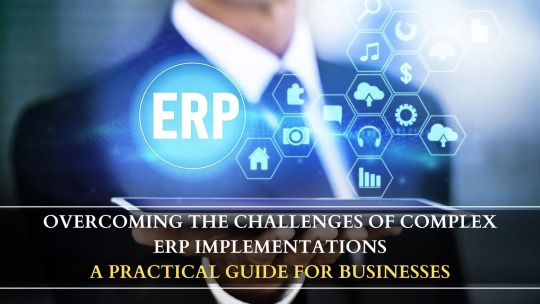
When it comes to Enterprise Resource Planning (ERP) systems, businesses recognize the immense potential for optimizing processes, improving efficiency, and gaining a competitive edge. However, complex ERP implementation continues to be a significant challenge. In a recent LinkedIn poll, the majority of businesses identified “Complex Implementation” as their biggest obstacle with ERP systems.
Why is ERP Implementation So Complex?
The complexities of ERP systems stem from their very nature—integrating multiple business functions such as finance, HR, supply chain, and customer relationship management (CRM) into a unified system. Here are some reasons why ERP implementation can be particularly challenging:
Customization Requirements: No two businesses operate exactly alike. This means that the out-of-the-box ERP solution often requires a high degree of customization to meet specific business processes. Tailoring the system involves detailed planning, design, and ongoing adjustments.
Data Migration: Transitioning legacy data from existing systems into a new ERP platform is a complex task. Businesses must ensure that data integrity, accuracy, and security are maintained during this process. It requires careful validation and cleansing to avoid operational issues post-implementation.
Change Management: Implementing an ERP system not only affects the IT department, but touches every part of the business. Employee resistance to change can slow down implementation. Proper training, communication, and support are essential to ensure smooth adoption.
Integration with Other Systems: Often, businesses rely on multiple third-party systems for specialized functions. ERP systems need to seamlessly integrate with these, ensuring data flows efficiently between them. Any glitches in integration can lead to operational delays and added complexity.
Time and Budget Overruns: The complexity of ERP implementations often leads to unexpected delays and cost escalations. Without proper planning, scope creep can derail projects, leaving businesses with systems that take longer to deploy than expected.
How JRS Dynamics Simplifies ERP Implementations
At JRS Dynamics Info Solutions, we’ve helped businesses navigate the complexities of ERP implementation by offering a comprehensive, customized approach. Our experts ensure smooth, timely ERP deployments by:
Deep Business Analysis: We begin by thoroughly understanding your unique business processes, identifying potential challenges, and designing solutions that fit your specific needs.
Seamless Data Migration: Our team uses advanced tools and strategies to securely transfer your data from existing systems into your new ERP environment with minimal disruption.
Dedicated Change Management: We support your teams with extensive training and provide ongoing consultation to ensure that employees are comfortable using the new system.
Efficient Integration: We ensure seamless integration with your other business tools and systems, enabling efficient communication between them without any data loss or delays.
On-Time, Within Budget: Our project management expertise ensures that ERP implementation remains on track, adhering to timelines and budgets, avoiding common pitfalls like scope creep.
Conclusion:
Implementing an ERP system can be complex, but with the right strategy, tools, and partner, businesses can overcome the challenges and reap the benefits. At JRS Dynamics, we pride ourselves on simplifying the ERP journey for our clients, ensuring a smooth and successful implementation.
If you’re considering an ERP system for your business and are worried about the complexities involved, reach out to us for a free consultation. Let’s work together to simplify your ERP transformation.
#SAP Business One#AI-Powered ERP Solutions#Complex ERP#Implementations D365 Business Central ERP#Dynamics365#ERP Dynamics 365#ERP#AI-Powered ERP Solutions - Dynamics 365#Experts Dynamics#Cloud ERP Offerings#Dynamics ERP Integration#ERP experts in India#ERP Software#ERP Software for Small Businesses#ERP Solutions#Finding the right ERP software solution
1 note
·
View note
Text
Develop a Winning Shopify App Migration Strategy

In today’s rapidly evolving e-commerce landscape, enterprise-level businesses must stay agile to remain competitive. For many, migrating their operations to a scalable, robust platform like Shopify Plus is a crucial step toward sustaining long-term e-commerce growth. One critical element of this transformation is developing a strategic approach to app migration. A well-executed Shopify App Migration Strategy can streamline operations, enhance customer experience, and safeguard against data loss and downtime. However, without a solid plan in place, the migration process can be fraught with risks, from revenue disruptions to compatibility issues.
For executives and decision-makers, understanding the intricacies of the migration process and leveraging Shopify’s capabilities is essential to ensuring a smooth transition. This guide will walk you through the key considerations and best practices for developing a winning Shopify app migration strategy, backed by industry insights and real-world success stories.
The Importance of a Shopify App Migration Strategy
Migrating apps to Shopify from another platform requires more than just a lift-and-shift approach. For enterprise-level e-commerce businesses, the stakes are high—errors during migration can lead to data loss, customer dissatisfaction, and costly downtime. According to a study by Forrester, the average enterprise suffers 30% productivity loss during poorly executed migrations, leading to a negative impact on both operations and revenue.
Having a structured Shopify App Migration Strategy is essential to avoid these pitfalls and capitalize on Shopify’s scalability, customization, and robust app ecosystem. Here are the primary reasons why having a strong migration strategy is critical:
Mitigating Downtime Risks: Downtime during the migration can cripple e-commerce operations. Every minute offline can lead to lost revenue and damage to brand reputation.
Ensuring Data Integrity: Preserving customer and operational data throughout the migration process is critical for continuity and compliance.
Enhancing Customer Experience: Maintaining a seamless customer experience during and after the migration ensures loyalty and trust.
Optimizing for Growth: Migrating to Shopify provides the opportunity to align your tech stack with your future growth plans, enhancing scalability and operational efficiency.
By understanding these risks and opportunities, businesses can better prepare for a migration that drives long-term e-commerce growth.
1. Assessing Your Current App Ecosystem
The first step in developing a successful Shopify app migration strategy is to assess your current app ecosystem and determine which apps are necessary to migrate, which need replacing, and which should be retired. Enterprise businesses often rely on a wide variety of custom-built and third-party apps to handle everything from inventory management to customer engagement. Migrating apps without a detailed assessment can result in redundancies, increased complexity, and operational inefficiencies.
Key Considerations for App Assessment:
Compatibility: Are your current apps suitable with Shopify’s platform and environment ? While Shopify’s app store hosts thousands of apps designed to meet a range of business needs, some legacy or custom apps may require customization or replacement.
Functionality Gaps: During migration, businesses have an opportunity to identify gaps in their current systems. Are there new Shopify apps or features that could replace outdated tools or improve workflows?
Redundancies: Over time, businesses can accumulate multiple apps with overlapping functionalities. App migrations are an opportunity to streamline operations by consolidating tools that offer the same value.
Custom Integrations: For enterprise-level operations, custom integrations between Shopify and other business-critical systems (CRM, ERP, etc.) are often required. Ensuring that these integrations work seamlessly post-migration is vital to preserving data flow and operational efficiency.
A comprehensive assessment ensures that only the most efficient and necessary apps are migrated, optimizing Shopify’s capabilities to boost operational efficiency.
Expert Insight:
“App migration is more than a technical exercise; it’s an opportunity to optimize workflows and reduce costs,” says Jane White, CTO of a leading e-commerce consultancy. “By focusing on core functionalities and eliminating redundancies, businesses can create a leaner, more scalable operation on Shopify.”
2. Planning the Migration Process
Once your app assessment is complete, it’s time to develop a detailed plan for executing the migration. This plan should focus on minimizing downtime, safeguarding data integrity, and ensuring that both the front-end and back-end of your Shopify store are fully operational during the migration process.
Critical Elements of the Migration Process:
Develop a Detailed Timeline: Establishing a clear timeline that outlines key milestones, such as data backups, testing, and app migration, ensures that all stakeholders are aligned and that potential delays are accounted for.
Create a Testing Environment: Before migrating live apps to Shopify, it’s essential to set up a sandbox or testing environment where you can troubleshoot compatibility issues and test functionalities without affecting your live store.
Data Backups: Backing up all critical data, including customer information, order history, and product details, is essential to avoid data loss during the migration process.
Customer Communication: Ensure that customers are aware of any potential disruptions to their shopping experience. Proactive communication can prevent negative customer sentiment during the transition.
Risk Mitigation: Identify potential risks—such as high-traffic periods or complex integrations—and develop contingency plans to address these challenges if they arise during migration.
Expert Insight:
“Careful planning and risk management are key to a successful migration,” advises John Thompson, a senior migration strategist. “A structured approach with clearly defined steps will allow you to anticipate challenges before they arise, ensuring a smoother transition.”
3. Ensuring Post-Migration Success
The final step in your Shopify App Migration Strategy is to ensure that everything runs smoothly once the migration is complete. A thorough post-migration plan includes testing app performance, monitoring customer feedback, and making necessary adjustments to optimize your new Shopify environment.
Key Post-Migration Considerations:
Performance Testing: Once the migration is complete, thorough testing is crucial. Test the performance of all migrated apps under typical traffic loads, ensuring that they function seamlessly with your new Shopify environment.
Customer Feedback: Pay attention to customer feedback during the first few weeks after the migration. If customers encounter issues with site functionality, be ready to address them quickly to avoid damaging the customer experience.
App Optimization: Post-migration is an excellent time to revisit your app settings and configurations to ensure that they are optimized for Shopify’s architecture. This may include updating app settings or integrating additional Shopify-native tools.
Long-Term Maintenance: Migration is not a one-and-done process. Enterprise businesses need to establish ongoing maintenance and update schedules for their apps to ensure they remain optimized and compatible with Shopify as new updates and features are released.
For further guidance on managing app migrations CLICK HERE .

Understanding the Shopify Ecosystem:
Merchant Adoption of Apps:
A significant portion of Shopify merchants utilize multiple apps to enhance their store functionality. While exact percentages can vary, studies suggest that a large number of merchants rely on apps for features such as marketing, customer support, and inventory management.
Source: E-commerce Times
The Importance of Migration:
Data Loss Risks:
Without a proper migration strategy, businesses can risk losing valuable customer data, order history, and product information. Studies have shown that data loss incidents can have severe financial and reputational consequences.
Business Disruption:
A poorly executed migration can lead to downtime, decreased sales, and damage to a brand's reputation. Research indicates that even brief periods of downtime can have a significant impact on customer satisfaction and revenue.
Conclusion: The Road to E-Commerce Success with Shopify
A well-planned and executed Shopify App Migration Strategy can unlock significant growth opportunities for enterprise-level businesses. By thoroughly assessing your current app ecosystem, creating a detailed migration plan, and optimizing your post-migration processes, your business can enjoy the full benefits of Shopify’s scalable platform.
At Oyecommerz, we specialize in helping enterprise businesses navigate the complexities of app migrations, ensuring a smooth transition that sets the stage for long-term success. Whether you’re migrating from a legacy system or looking to optimize your existing Shopify setup, our team is here to guide you through every step of the migration process. Contact us today to learn more about how we can help you develop a winning Shopify app migration strategy tailored to your business needs.
1 note
·
View note
Text
The Critical Role of Data in ERP Systems

In today's rapidly evolving business environment, the role of data in driving operational efficiency and strategic decision-making has never been more crucial. For companies looking to streamline operations, enhance productivity, and ensure long-term growth, an Enterprise Resource Planning (ERP) system is often the solution. One key element that makes ERP systems powerful is their ability to consolidate, analyze, and utilize data efficiently across various business processes.
In this blog, we will explore the critical role data plays in ERP systems and how an ERP software company in Navi Mumbai can help businesses harness its potential. We will also highlight the importance of ERP implementation services in Navi Mumbai and the value of expert ERP consulting services in Navi Mumbai to ensure data is optimized within your ERP solution.
ERP systems are designed to unify a company’s core business functions—ranging from accounting and inventory management to customer relationship management (CRM) and human resources. At the heart of this integration lies data.
Data from different departments is consolidated into a single, unified system. This allows for real-time access to critical business information, ensuring that decision-makers have the tools they need to make informed decisions. However, for this integration to work smoothly, the data must be clean, consistent, and well-organized before it’s migrated into the ERP system.
An ERP software company in Navi Mumbai can provide businesses with the expertise to ensure that their data is well-structured, ensuring a smooth transition and efficient data integration into the new system.
Data Quality: The Key to Successful ERP Implementation
A successful ERP implementation largely depends on the quality of the data being used. Poor data quality can lead to errors, inefficiencies, and costly disruptions. ERP implementation services in Navi Mumbai focus on ensuring that data migration is accurate and thorough, helping businesses avoid the pitfalls of bad data.
Data should be:
Clean: Remove duplicates, irrelevant information, and ensure that all data is up to date.
Consistent: Standardize data formats across departments to avoid discrepancies.
Comprehensive: Ensure all relevant data is included so that no critical information is missing.
These steps are essential because ERP systems rely on accurate data to automate workflows, generate reports, and provide insights that drive business strategies. An experienced team offering ERP implementation services in Navi Mumbai ensures that the data going into your system is prepared correctly, allowing your ERP to function effectively from day one.
The Role of Data in Decision-Making
One of the major advantages of an ERP system is the ability to make data-driven decisions. With real-time data access across departments, ERP systems offer comprehensive reports and analytics that help businesses understand their performance, predict future trends, and optimize processes.
By collecting and analyzing data in real-time, companies can:
Track key performance indicators (KPIs) across all departments.
Monitor financials, sales, inventory, and other vital metrics.
Make informed decisions that improve efficiency, reduce costs, and drive growth.
ERP consulting services in Navi Mumbai play a pivotal role in helping businesses maximize the value of their data. Consultants not only guide companies through the initial setup but also provide insights into how best to use their data to achieve strategic goals. Their expertise ensures that businesses are not just collecting data but are using it to its full potential.
Data Security and Compliance
Another critical aspect of data in ERP systems is ensuring its security and compliance with industry regulations. With increasing concerns over data breaches and stricter regulations like GDPR, safeguarding data within an ERP system is a top priority.
ERP systems must have robust security measures to protect sensitive business information. An ERP software company in Navi Mumbai can provide the tools and expertise needed to ensure that your data is secure. They can help implement measures such as encryption, user access controls, and regular audits to safeguard your data.
Additionally, ERP consulting services in Navi Mumbai can ensure that your system complies with relevant industry standards and regulations, providing peace of mind that your data is not only secure but also compliant with legal requirements.
Conclusion: Empower Your Business with the Right Data and ERP Solution
Data is the backbone of any ERP system, and its quality, security, and proper utilization are critical to the success of an ERP implementation. Whether you're a small business or a growing enterprise, having the right ERP system, with the support of expert ERP implementation services in Navi Mumbai, is essential to unlock the full potential of your data.
Choosing the right ERP software company in Navi Mumbai and leveraging ERP consulting services in Navi Mumbai can ensure that your business processes are optimized, data-driven, and future-proof. By investing in high-quality data management within an ERP system, businesses can make smarter decisions, improve efficiency, and achieve sustainable growth.
0 notes
Text
Unlocking Business Efficiency with Odoo Consulting and Website Solutions in Jaipur
The Power of Odoo for Businesses
Odoo’s versatility makes it a top choice for businesses looking for an all-in-one platform to handle daily operations. With over 30 applications that can be seamlessly integrated, Odoo helps manage everything from CRM, accounting, and sales to manufacturing, inventory, and more. The platform’s modular nature ensures that businesses only use the features they need, reducing complexity and enhancing productivity.
However, while Odoo is user-friendly, it requires customization and integration for optimal performance. This is where odoo consulting in jaipur becomes essential. Professional consultants have a deep understanding of the platform’s capabilities and know how to tailor it to meet specific business needs. By working closely with experts, companies can ensure they are using the system to its full potential, unlocking all the features that can drive efficiency and growth.
Why Opt for Odoo Consulting in Jaipur?
Jaipur, a rapidly growing city with a thriving business ecosystem, has seen an increasing number of organizations turn to Odoo to streamline their operations. For many companies in the region, local expertise is key to a successful Odoo implementation. Consultants based in Jaipur understand the unique challenges and opportunities present in the local market, making them ideally suited to provide tailored solutions.
Whether you are a small business just getting started with Odoo or a larger enterprise looking to optimize your existing system, Odoo consulting in Jaipur offers a range of services. From initial setup and customization to training and ongoing support, these consultants ensure a smooth transition to the platform. They help businesses avoid common pitfalls, ensure proper integration with existing tools, and guide them through the complexities of data migration and process automation.
Enhancing Your Online Presence with an Odoo Website in Jaipur
In addition to managing internal operations, businesses today must also focus on their online presence. Odoo offers powerful website building tools that enable companies to create dynamic, responsive websites with ease. An odoo website in jaipur can help businesses attract more customers, showcase their products or services, and provide a seamless online shopping experience.
The beauty of using Odoo for website development is the integration it offers with other business functions. For example, e-commerce businesses can link their websites with inventory and sales applications, allowing for real-time updates on stock levels and order processing. This level of integration improves both customer experience and operational efficiency.
Building an Odoo website in Jaipur allows companies to have a professional online presence without the need for multiple third-party tools. With the help of experienced developers and designers, businesses can create customized websites that reflect their brand identity and meet specific customer needs. Moreover, having local expertise ensures that the website aligns with the cultural and market demands of the Jaipur region.
The Future of Odoo in Jaipur
As Jaipur continues to grow as a hub for business and technology, the demand for Odoo consulting in Jaipur and Odoo website solutions is expected to rise. Companies looking to stay ahead of the competition will increasingly turn to this platform for its ability to improve efficiency, enhance customer relationships, and drive sales.
In conclusion, whether it's optimizing internal workflows or creating a stunning online presence, Odoo is the go-to solution for businesses in Jaipur. By partnering with local consultants and website developers, companies can harness the full power of Odoo to achieve long-term success.
0 notes
Text
Unlocking Business Potential with Zoho CRM Consulting Services
In today's dynamic business landscape, harnessing the power of customer relationship management (CRM) systems has become indispensable for organizations aiming to streamline operations, boost sales, and foster enduring client relationships. Among the myriad of CRM solutions available, Zoho CRM stands out as a versatile and comprehensive platform that caters to businesses of all sizes and industries. However, maximizing the potential of Zoho CRM often requires expert guidance and strategic implementation. This is where Zoho CRM Consulting Services come into play, offering tailored solutions to empower businesses in their CRM journey.
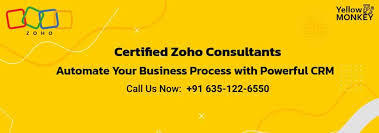
Understanding Zoho CRM Consulting Services
Zoho CRM Consulting Services encompass a range of offerings aimed at assisting businesses in leveraging the full capabilities of the Zoho CRM platform. From initial setup and customization to ongoing support and optimization, these services are designed to address the unique needs and objectives of each client. Whether a company is transitioning from a legacy CRM system or implementing CRM for the first time, consulting services provide the expertise and guidance necessary for a successful implementation.
Key Benefits of Zoho CRM Consulting Services
Strategic Planning and Customization: One of the primary benefits of engaging Zoho CRM Consulting Services is access to strategic planning and customization expertise. Consultants work closely with clients to understand their business processes, goals, and pain points, developing a tailored CRM strategy that aligns with their objectives. This includes customizing Zoho CRM modules, fields, and workflows to fit specific business requirements, ensuring optimal efficiency and user adoption.
Implementation and Integration: Implementing a CRM system involves more than just installing software; it requires seamless integration with existing systems and processes. Zoho CRM Consultants have the technical know-how to integrate Zoho CRM with other business applications, such as email marketing platforms, accounting software, and e-commerce platforms, creating a unified ecosystem that enhances productivity and data accessibility.
User Training and Adoption: A common challenge faced by organizations during CRM implementation is user resistance and low adoption rates. Zoho CRM Consulting Services include comprehensive training programs aimed at equipping users with the knowledge and skills needed to effectively utilize the platform. Whether through onsite workshops, virtual training sessions, or self-paced tutorials, consultants ensure that users feel confident and empowered to leverage Zoho CRM to its fullest potential.
Data Migration and Cleanup: Migrating existing data from legacy systems or spreadsheets into Zoho CRM can be a daunting task fraught with potential pitfalls. Zoho CRM Consultants employ best practices and data migration tools to facilitate a smooth transition, ensuring that valuable customer information is accurately transferred without loss or corruption. Additionally, consultants assist in data cleanup efforts, identifying and rectifying inconsistencies or duplicates to maintain data integrity.
Workflow Automation and Optimization: Automation is at the heart of Zoho CRM's functionality, enabling businesses to streamline repetitive tasks, improve efficiency, and enhance customer engagement. Zoho CRM Consultants specialize in designing and implementing automated workflows tailored to specific business processes, from lead management and sales pipeline tracking to customer support and follow-up. By optimizing workflows, consultants help organizations achieve greater productivity and scalability.
Choosing the Right Zoho CRM Consulting Partner
With the growing demand for CRM consulting services, choosing the right partner can be a daunting task. When selecting a Zoho CRM Consulting provider, it is essential to consider factors such as expertise, experience, and track record. Look for consultants who are certified Zoho CRM experts with a proven history of successful implementations across diverse industries. Additionally, seek out testimonials and case studies from previous clients to gauge the consultant's credibility and customer satisfaction levels.
Conclusion
In an increasingly competitive business environment, leveraging the power of CRM technology is no longer optional—it's imperative. Zoho CRM offers a robust solution for businesses seeking to centralize customer data, streamline processes, and drive growth. However, realizing the full potential of Zoho CRM requires more than just software—it demands strategic planning, expert implementation, and ongoing support.
Zoho CRM Consulting Services provide the expertise and guidance necessary to unlock the full capabilities of the platform, empowering businesses to thrive in today's digital economy. Whether embarking on a CRM implementation journey for the first time or seeking to optimize an existing system, partnering with a trusted Zoho CRM Consulting provider can make all the difference in achieving success.
0 notes
Text
Seamlessly Move to Magento 2: Best Practices for Migration Success
Migrating your ecommerce platform to Magento 2 comes with a host of advantages, from boosted performance to new features, but can involve disruptions if not handled properly. Your goal should be making the transition invisible to customers while positioning your business for innovation and revenue growth. The key is developing a thoughtful, phased migration plan covering all site components while tapping proven tools to port data and configurations seamlessly behind the scenes. Follow best practices around readiness, testing, go-live, and follow-up, and you gain faster time-to-value on your investment while avoiding potential pitfalls during the rollout. Your customers continue to enjoy their shopping experience while you build future capabilities.

Assess Readiness
Take inventory of all existing integrations : Document all third-party integrations connecting to the current Magento 1 site including payment systems, shipping carriers, CRM tools, ERP platforms etc. Map out the specific plugins, data flows, dependencies and configurations
Identify any outdated extensions or custom code : Audit all site extensions and custom code elements checking for outdated, vulnerable or incompatible pieces with Magento 2. This minimizes technical issues down the line.
Evaluate site for technical debt to resolve : Assess opportunities during the migration like consolidating multiple outdated extensions, removing redundant custom code or legacy integrations, upgrading servers etc. This “tech debt” cleanup saves cost and complexity later.
Data Migration Strategy
Seamlessly porting legacy data enables continuity post-migration while unlocking the full capabilities of Magento 2. The process starts by inventorying all existing product catalogues, customer lists, order archives and other site data spanning back years. Choose either cloud ETL tools or Magento’s Migration Tool to efficiently map and transfer datasets to the new platform in batches. Extensively test migration runs in isolated environments to catch any gaps in the data mapping logic before cutover.
Codify data validation checks that safeguard vital information made it over intact after any migration test run. Assess that total order values, product SKU information, registered user accounts and all other key details carry through accurately. Refine the migration methodology via ongoing iteration to handle edge cases that arise over numerous test cycles. Follow this blueprint for migrating datasets seamlessly even at large scale and with customizations.
Testing & Replat forming
Rigorously testing the migrated Magento 2 site across environments safeguards smooth cutover. The QA process first establishes a staging environment with copied production data, extensions and customizations. Conduct functionality testing across the entire shopper journey - product searches, category navigation, checkout etc. Verify key integrations with payment gateways, shipping carriers and other third-parties are correctly configured in the new ecosystem. Tune and load test infrastructure elements like CDNs, caches and servers to handle expected Magento 2 traffic. Address any code or capability gaps revealed between the legacy and new platform during these tests. Following such test-driven migration practices minimizes the likelihood of issues post go-live. With comprehensive test coverage, the team can confidently re-platform and cutover to realize the advanced capabilities of Magento 2.
Go-Live Launch
Redirect traffic seamlessly to new site : Use 301 redirects and sitemaps to gracefully shift traffic to the new Magento 2 shop without losing SEO equity.
Closely monitor site KPIs with analytical tools : Activate enhanced analytics to track key metrics on customer behaviour, sales, site performance post-launch. Address data anomalies.
Support teams through any issues during transition : Have technical teams on standby to quickly address integration, performance or functionality issues that may emerge after cutover.
Post Launch Follow-up
Run search crawl to maintain SEO : Execute a site-wide crawl to inform search engines of the new site location and content to retain rankings.
Identify and build any missing capabilities : Audit new solution against legacy site to reveal functionalities requiring rebuilding during optimization phase.
Drive continuous optimization and innovation : With migration complete, formulate product roadmap and backlog to take advantage of native M2 capabilities for revenue goals.
Conclusion
Migrating to Magento 2 brings immense business benefits but requires meticulous planning to minimize disruption. By taking a phased approach - thoroughly assessing your starting state, formulating data and test strategies, gracefully transitioning traffic, and optimizing post-launch - retailers can supersede any migration pitfalls. Follow proven guidelines around readiness, testing, go-live, and follow-up for seamless continuity of customer experience. Invest upfront in a migration methodology modelled on success stories. The payoff is realizing the sales, innovation and customer advantages of a robust new commerce platform built for growth and competitive differentiation.
0 notes
Text
Navigating a Salesforce Migration: Best Practices and Pitfalls to Avoid
Migrating to a new Salesforce instance can be a transformative step for businesses seeking to optimize their CRM processes. Whether you're transitioning from a different CRM platform or upgrading to a more advanced Salesforce edition, a well-planned migration is essential for a seamless transition. This article outlines best practices and common pitfalls to help guide your Salesforce migration process.
1. Thorough Pre-Migration Assessment
Before diving into the migration process, conduct a comprehensive assessment of your existing CRM data and processes. Identify what needs to be migrated, what can be archived or discarded, and what customizations are required in the new instance. This step sets the foundation for a successful migration.
2. Engage Stakeholders and End-Users
Involve key stakeholders, including sales, marketing, customer support, and IT teams, in the planning and decision-making process. Gather input on customization requirements and user preferences to ensure the new instance meets the needs of all departments.
3. Data Cleaning and Validation
Perform a thorough data cleansing process to eliminate duplicates, outdated records, and inconsistencies. Validate data integrity to prevent issues post-migration. This step is crucial to maintain data accuracy and reliability in the new system.
4. Customization and Configuration
Map out the customizations required in the new Salesforce instance. This may include custom fields, objects, workflows, and automation rules. Leverage Salesforce's powerful customization tools to tailor the platform to your specific business needs.
5. Plan for Data Migration
Choose the most suitable data migration method based on your data volume and complexity. Options include Salesforce's native tools, third-party migration apps, or manual data entry. Ensure you have a rollback plan in case of unexpected issues during migration. Salesforce Integration Service
6. Test Rigorously
Conduct thorough testing to validate data integrity, functionality, and user permissions in the new instance. Create a sandbox environment to simulate real-world usage and address any issues before going live.
7. Provide Training and Support
Offer comprehensive training sessions for end-users to familiarize them with the new Salesforce environment. Provide ongoing support to address any questions or concerns, ensuring a smooth transition.
0 notes
Text
A Comprehensive Guide for Migrating from Zoho CRM to Vtiger CRM
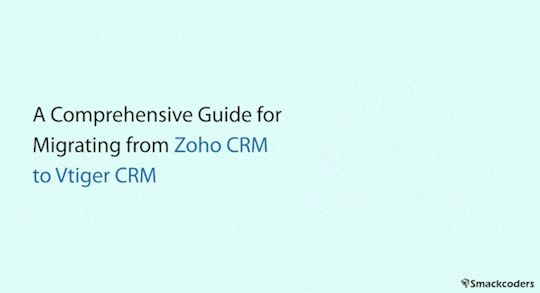
Are you already in the process of migrating from Zoho to Vtiger? Or just considering starting it, we’re thrilled to have you here on our blog. If you are looking for a cost-effective and reliable solution to move your business data from Zoho CRM to Vtiger CRM you have landed in the right place. Here we provide you with an easy-to-follow guide. So, no matter your level of CRM experience or just getting started, this blog has something for you.
We will provide expert advice and step-by-step instructions on how to migrate your data from Zoho to Vtiger. We will also discuss the advantages of using Vtiger and the potential pitfalls you may encounter. So, if you are ready to make the switch, let’s get started!
Pre-Migration Checklists
Before Migrating your records to Vtiger CRM make sure your exported file records satisfy the below condition.
File Size: The file size of your exported file should not exceed 50 MB.
File Format: The exported file should be in one of the following formats for importing.
CSV (Comma-Separated Values) – All records will be imported/exported into any CRM module only using the CSV files.
VCF (Virtual Contact File)- Only contacts will be imported using the VCF file.
ICS (iCalendar File)- Only the tasks and events of the calendar will be imported using the ICS file.
Mandatory fields: The exported file should have all the mandatory fields to fill in Vtiger CRM. If your exported file is not provided with the mandatory fields, then the default value will be used. You can set your default values by navigating to Settings>>Module management>>Module Layouts and Fields.
Map all the mandatory fields
Ensure all the Mandatory fields are mapped with your CRM fields. A warning will be displayed if the mandatory fields are not mapped properly.
If your exported file does not provide a value for a mandatory field, then the default layout value of the field is used.
Records cannot be imported simultaneously into two different modules. Additionally, you cannot import records into the same module at the same time as another user.
Export records from Zoho CRM
Before exporting the records it is important to note that Zoho CRM can export a maximum of 3000 records from the module in CSV format.
Unlike import, you cannot export records of all the modules at a time. You can only export records from one module at a time.
Steps to export records from Zoho CRM
Step 1: Navigate to the Settings<<Data administration tools<< Export.
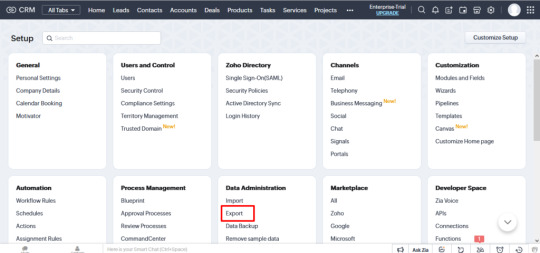
Step 2: Select the module from the drop-down from which you want to export records.
Step 3: Click on Export. Now the records of the selected module will be exported as .csv files.
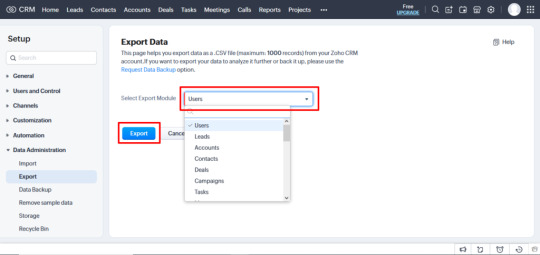
Import Records to Vtiger CRM
Once you export all the modules from Zoho CRM, it is time to import all your .csv files into the Vtiger CRM.
Steps to import records in Vtiger CRM
Step 1: Log in to your Vtiger CRM account.
Step 2: Navigate to the modules one by one which you want to import into your Vtiger CRM.
Step 3: Click on the Import icon at the top of the Module’s list view.
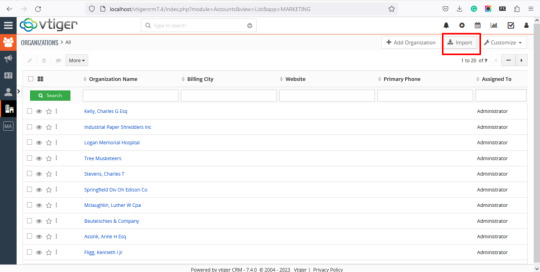
Step 4: On the Import Wizard, there you need to execute three processes for the successful migration of records.
Upload your CSV– Click on Select from my Computer and upload the desired .csv files of that module.
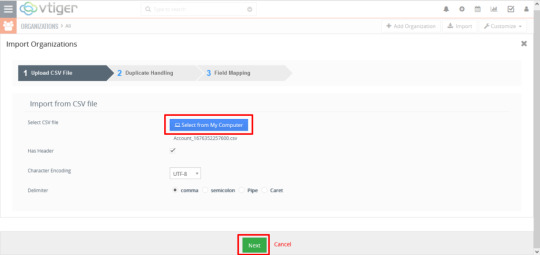
Step 5: Duplicate Handling– First you have to select how the duplicate records are handled from the drop-down.
You can Skip the duplicate records
Overwrite the duplicate records with the original data
Merge duplicate records with the original and comprise a single record.
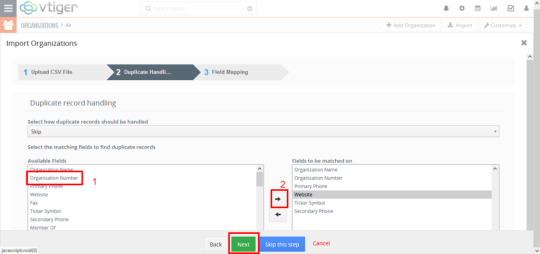
Step 6: Field Mapping.
In field mapping, map all the mandatory fields and the appropriate fields based on your business needs.
Note:
The organization, potentials, and project tasks of Vtiger CRM are referred to as Accounts, deals, and tasks in Zoho CRM respectively.
Carefully map all the required fields and click on Import.
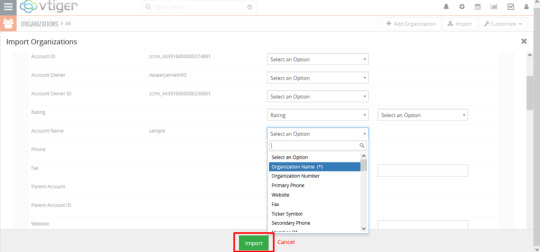
Step 7: Review Import Summary
Now all your Zoho records are successfully imported into your Vtiger CRM.
The import displays the
Total number of records scanned
Number of records successfully imported
Number of records created
Number of records overwritten, skipped, and merged
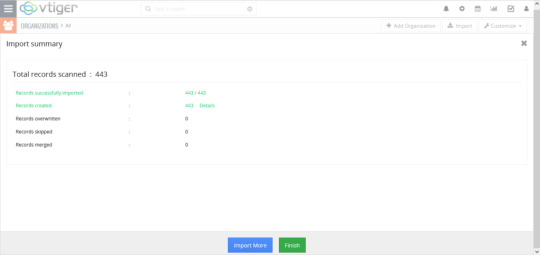
Likewise, you can export all the modules of your Zoho CRM one by one and Import them into the corresponding Vtiger CRM modules.
Choose the Safest Data Migration
Though the migration from Zoho CRM to Vtiger CRM is an intimidating task, with the right tools and knowledge, it can be relatively done with much patience and concentration. And of course, it is too time-consuming.
You can easily migrate your records without any data loss through our efficient migration service. Our technical experts carefully handle your records and take care of the smooth migration from Zoho CRM to Vtiger CRM. You can easily contact us for the data migration at [email protected]. The transition can be an exciting one and with the right guidance and support, the migration process can be completed quickly and seamlessly.
With Vtiger’s powerful CRM options and Zoho’s robust collaboration features, this migration can be a great opportunity to take your business to the next level. With the help of migration tools and the right knowledge, you can make the transition with minimal disruption to your operations. Start your Zoho to Vtiger migration today and take your business to the next level!
1 note
·
View note
Link
Data Migration Checklist: Reasons and Nuances
Constantly improving customer relationship management is the task that you cannot omit, because your target audience grows and changes with time. Developing your brand according to the preferences of your clients and attracting new ones is a guarantee of a successful business. It is vital to show your customers that you value them and aim at offering a better service than the one your competitors provide.
Your customer relationship management (CRM) software may also need some upgrades or should even be migrated in order to let your data be efficiently organized. If a CRM platform is not up-to-date or is not even fulfilling the basic needs, it is time to consider some other options. Luckily, there is a wide variety of custom CRM development services that can be given to a company in need. In today’s article, we will look at the advantages of the CRM data migration process and pinpoint some tips that you should pay attention to minimize the possible risks and help your business to thrive.
#data migration#CRM#crm development#crm system#crm integration#crm software#custom software solutions#custom software development#custom software#custom software application#software development#softwaredevelopment#software#web development#application development#developers#development#outsourcing#it staff augmentation#it staffing company#staff augmentation#it staff offshoring
0 notes
Text
Step-by-Step Guide to a Smooth Salesforce Implementation: Best Practices for Success
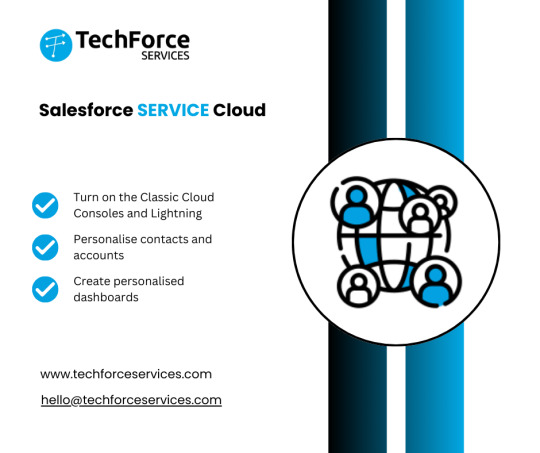
Implementing Salesforce can be transformative, but it requires careful planning and execution. For businesses aiming to streamline operations, enhance customer relationship management (CRM), and drive revenue, Salesforce is a powerhouse. However, achieving these benefits often hinges on a well-executed implementation plan that avoids common pitfalls and leverages best practices.
Here’s a step-by-step guide to a smooth Salesforce implementation using a tried-and-true framework with insights from TechForce Services, an experienced Salesforce implementation partner.
Step 1: Define Clear Objectives
Before diving into implementation, begin by establishing your objectives. What do you want Salesforce to achieve for your business? Setting clear, measurable goals will help you stay focused and aligned throughout the process. Are you aiming to improve customer data management, enhance sales processes, or optimize marketing campaigns? The answers to these questions form the foundation of your Salesforce framework.
Key objectives might include:
Improving customer service efficiency
Increasing cross-functional collaboration
Enhancing data visibility for informed decision-making
Boosting sales productivity and forecasting accuracy
Step 2: Assemble the Right Implementation Team
Next, build a team that includes key stakeholders from each department that will use Salesforce. This might include sales, marketing, customer support, and IT. It’s equally crucial to choose a project manager who will oversee the entire implementation process. TechForce Services, as your Salesforce implementation partner, can bring experience and insights to avoid common issues and streamline the transition.
In addition to your in-house team, consider hiring TechForce Services, which specializes in Salesforce implementations. As a partner, they bring technical expertise, guidance on best practices, and support with complex configurations. Selecting the right partner is essential, so evaluate their experience, success stories, and industry expertise to ensure they fit your needs.
Step 3: Plan and Outline the Salesforce Framework
An organized Salesforce framework is key to keeping the project on track. Start by mapping out a timeline with milestones, deliverables, and deadlines. Include:
Data migration strategy
Customization requirements
Integration points with existing systems
User training and support
In your planning, account for future scalability. Ensure the system is flexible enough to adapt to changes in your business, such as increased data or added functionalities. The best implementation frameworks are built with flexibility, scalability, and future growth in mind, and TechForce Services can guide you in designing a robust and future-ready framework.
Step 4: Data Migration and Cleaning
One of the most difficult parts of using Salesforce is frequently data migration.Before importing data into Salesforce, ensure your data is clean, organized, and accurate. Incomplete or duplicate data can hinder adoption and decrease user trust in the system.
Data Assessment: Review your existing data to identify any gaps or inaccuracies.
Data Cleaning: Eliminate duplicate or outdated information.
Data Structuring: Organize data to align with Salesforce’s data model.
Data Migration: Use Salesforce’s import tools or work with TechForce Services to move data seamlessly.
A well-structured data migration plan is crucial for a smooth Salesforce implementation. Engaging both your IT team and TechForce Services ensures a seamless transition.
Step 5: Customize to Fit Business Needs
Salesforce’s flexibility is one of its greatest assets. It allows you to customize features, workflows, dashboards, and reports according to your unique business requirements. However, avoid over-customizing, as this can lead to increased complexity and potential issues in maintenance and future upgrades.
Key areas for customization include:
Workflow Automation: Increase efficiency by automating repetitive operations.
Custom Fields: Tailor fields to capture the specific data your teams need.
Dashboards and Reports: Set up customized dashboards and reports to track KPIs.
Remember, customization is meant to serve your objectives, not overcomplicate them. A good Salesforce implementation partner like TechForce Services can help identify where customization adds value versus where it could complicate the framework.
Step 6: Integrate with Existing Systems
One of the key strengths of Salesforce is its ability to integrate with other software. Whether it’s ERP, e-commerce, or marketing automation tools, Salesforce can be configured to communicate with various systems. Successful integration ensures that data flows smoothly between systems, creating a single source of truth for customer information.
Work with TechForce Services to map out integration requirements and address potential challenges. Consider data flow, security, and API capabilities to make sure integrations work seamlessly within your Salesforce framework.
Step 7: User Training and Adoption
For any software implementation to succeed, users need to understand how to use it effectively. Begin by designing a training program that suits your team’s needs, ensuring they feel confident navigating and utilizing Salesforce to its full potential.
Best practices for user training:
Conduct role-based training sessions to teach users the features most relevant to their daily work.
Create a knowledge base with reference materials, FAQs, and tutorials.
Encourage hands-on practice to allow users to get comfortable with the system.
A smooth Salesforce implementation isn’t complete without high adoption rates, so invest in training and communicate the benefits to your team. TechForce Services can offer training resources and guidance to ensure a smooth transition.
Step 8: Test Thoroughly and Launch
Before going live, conduct extensive testing to make sure everything works as expected. Testing should include all features, customizations, and integrations within your Salesforce framework. Use scenarios that simulate real-world use to uncover any potential issues.
Testing best practices:
Conduct user acceptance testing (UAT) to confirm that the system meets business needs.
Identify and fix any issues that surface during testing.
Communicate the testing phase results with your team to ensure everyone is aware of system capabilities.
Once testing is complete and issues are resolved, you’re ready for a smooth launch. Ensure that all users are informed of the go-live date and understand any next steps.
Step 9: Monitor and Optimize
After implementation, the work isn’t over. Regular monitoring will help identify any performance issues, user challenges, or opportunities for improvement. Schedule periodic reviews to assess if the system continues to meet business objectives. Many businesses choose to engage their Salesforce implementation partner for ongoing support to help optimize features and make necessary adjustments.
Some monitoring and optimization practices include:
Regularly reviewing dashboards and reports to assess KPIs.
Obtaining consumer input in order to determine possible enhancements.
Staying updated on Salesforce releases for new features and functionalities.
Conclusion
A well-planned Salesforce implementation is a step toward transforming customer relationships and improving business efficiency. By following these steps—defining objectives, assembling the right team, planning a robust Salesforce framework, ensuring data quality, customizing wisely, integrating seamlessly, training thoroughly, and monitoring regularly—you’ll set the stage for success.
Partnering with experienced Salesforce implementation partners can also bring invaluable expertise and guidance. Taking these steps will help you make the most of your Salesforce investment, positioning your organization for long-term growth and success.
0 notes
Text
Dynamics 365 CE Quick Start
MS Dynamics 365 CE adoption packs will help you get aboard your Dynamics 365 CRM quickly with an accelerated fixed scope pack. As many businesses become more agile and digital, they are seeking to upgrade from basic contact management systems so they can benefit from the range of capabilities for sales, marketing, and customer support.
Soluzione now offers an accelerated fixed scope approach that allows organizations to get started in no time with Dynamics 365 CE (CRM) for a fixed price.
Dynamics 365 Implementation Package Quick Start 3 Day Implementation package is perfect for small businesses who have no existing CRM system in place and only in need of basic rollout to handle leads. It comes with the following facilities:
· Configure the Out of Box D365 for Sales (D365 SalesPro) license correctly for upto 5 users.
· Configure Users, Rights, and Security correctly (Using Standard Security).
· Configure the components correctly to interact with your Office 365 Licenses including Teams and Outlook to receive mail notifications and alerts from/to Dynamics 365 Sales.
· Standard enablement of D365 and SharePoint Integration for Document Management for standard sales entities.
· Integrate a sample set of data into the CRM as (Accounts, Contacts, Leads, and Opportunities) in the Dynamics 365.
· Demonstrate and/or Train for (4-5hrs as required) on the operations and key administrative features.
Soluzione's approach, guidance, and collaborative methodology ensure that we stay on course to meet the agreed objective together. We are experienced and take care to make your CRM project a success and avoid the typical pitfalls while doing so. Choose any of our Dynamics 365 CE implementation packages based on your requirement and budget.
Below are few blogs and articles that can help you know more about Dynamics 365 CRM and improve users experience as well as productivity.
· Dynamics 365 CE Unified Interface Migration Plan
· Smart Button in Ribbon Workbench for D365 Unified Interface
· How To Replace Deprecated Client API With New API
· Create A Canvas APP in PowerApps from Scratch
Soluzione is Recognized Among The Top Microsoft Dynamics CRM Consultant
1 note
·
View note